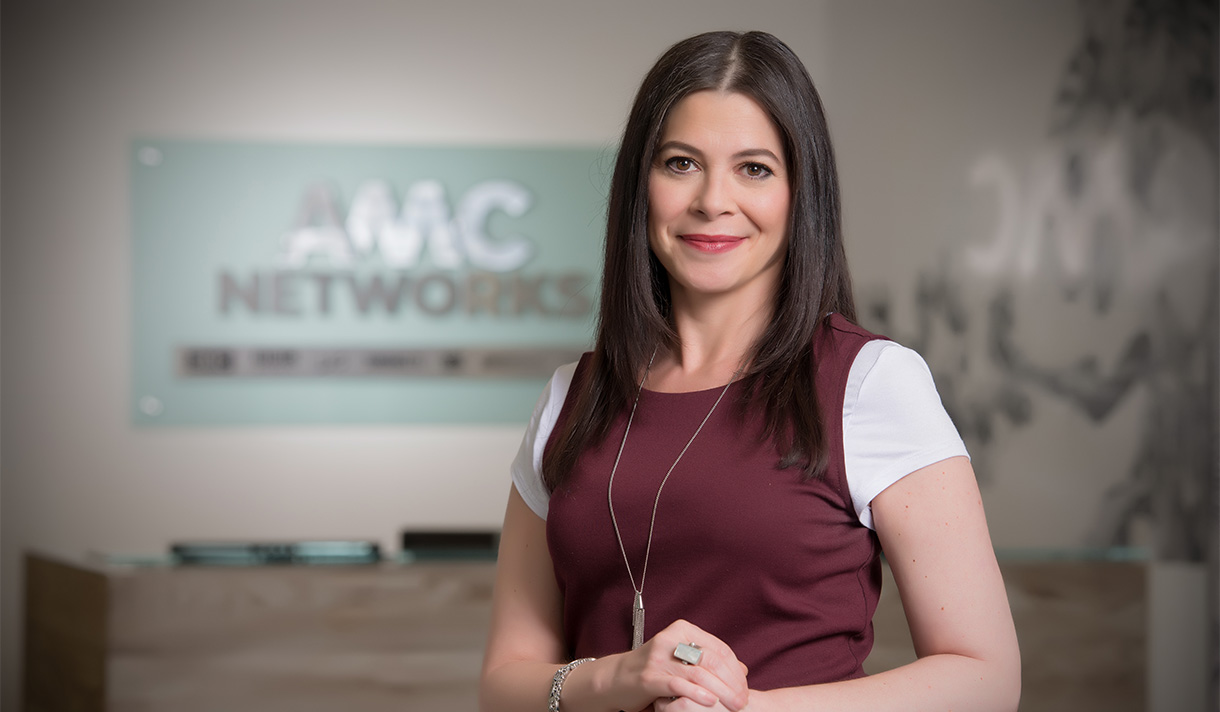News
Broadcasting Success: Alumni in the Rapidly Changing Media Industry
April 14, 2017
Photo: Christine Bragan (B.F.A. ’03) is vice president of marketing and communications for AMC Networks.
Whether in front of the cameras or behind the scenes, NYIT alumni serve on the front lines of a rapidly changing media industry.
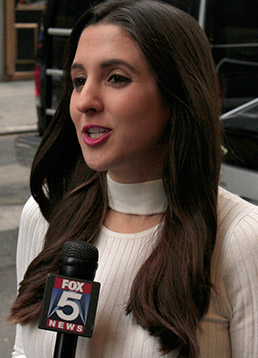
Dana Arschin (M.A. ’11) is a reporter for Fox 5.
When TV reporter Dana Arschin (M.A. ’10) filed her first story in front of a camera, she interviewed a grade school gym teacher about preparing for the New York City Marathon. Arschin was just 10 years old. The segment was part of Spotlight on Jackson, a TV news program created by teachers at George A. Jackson Elementary School in Jericho, N.Y. “Early on I was bitten by the news bug,” says Arschin. She has come a long way since then, and is now a reporter for Fox 5 News in New York.
Years after her first story, while she was working as an intern at WNBC at 30 Rockefeller Plaza in Midtown Manhattan, Arschin discovered LI News Tonight, NYIT’s student-run nightly news show that aired evenings on Long Island cable TV. She decided to enroll, and after earning her master’s degree in broadcast journalism, Arschin reached out to NYIT’s alumni network to look for ways to begin her career as an on-camera reporter. She connected with Charlie Malicki (B.F.A. ’09), a cameraman at News 12 Long Island. “He helped me get an internship at News 12. This eventually led to my first on-air reporting job at News 12 The Bronx/Brooklyn,” she says. “NYIT taught me how to shoot, write, and edit, which were the exact skills I needed to land that job.” Arschin went on to earn a New York Emmy at News 12 for reporting on New York City’s cleanup efforts in the wake of several major snowstorms in 2014.
She joined Fox 5 in August 2016 and covers the New York Tristate area. To find story ideas, Arschin often relies on technology. “I’ll get dozens of emails a week from viewers,” she says. “My professional Facebook page is especially useful for them to contact me about potential stories that are impacting local communities.” A normal day goes like this: Dana is assigned a story and camera operator then heads out into the field. She writes the segment either back in the studio or remotely on location after reviewing all of the footage. Then, the story (usually around a minute and a half long) airs during Fox 5 evening broadcasts. “I learned to be efficient and make great use of my time, thanks to my NYIT experience,” she adds. “I don’t know where I’d be without it.”
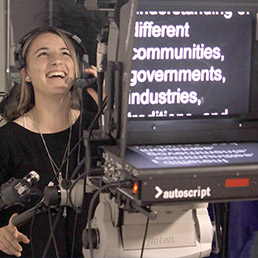
An NYIT student operates a studio camera equipped with a teleprompter for Globesville.
Channels of Disruption
Arschin’s NYIT experiences are a strong testament to the university’s ability to connect students with rewarding careers in the broadcasting industry. But just as these markets continued to evolve, so, too, does NYIT. Case in point: Globesville, NYIT’s student-run web channel that launched in 2015 and broadcasts live news, student films, music, sports, and gaming content.
“Globesville is the heir apparent to LI News Tonight,” says Professor Don Fizzinoglia (M.A. ’83), chair of the communication arts program in NYIT College of Arts and Sciences. “It’s a great showcase for student work.” To complement these experiential endeavors, NYIT also launched new bachelor’s degree programs in communications and media production; digital film and television production; advertising, public relations, and technology; and global and electronic journalism. “The very nature of communication has changed thanks to the Internet,” says Fizzinoglia. “We wanted to offer more specialized learning to match what students want and need to learn to be competitive in today's job market.”
A decade ago, people in the TV industry would wonder what’s going to happen in the next five to 10 years. Now, it’s how do we plan for the next 24 months?
Christine Bragan
Through the programs, NYIT students will learn to adapt to a rapidly changing media marketplace—something that Christine Bragan (B.F.A. ’03), vice president of marketing and communications for AMC Networks, is very familiar with.
The convergence of mobile technology and faster Internet speeds has led to dramatic shifts in TV viewing habits in the past few years. In 2015, Flurry Analytics announced that U.S. consumers spent 198 minutes on mobile apps per day compared to 168 minutes watching television. That’s nearly an hour more compared to 2014. “A decade ago, people in the TV industry would wonder what’s going to happen in the next five to 10 years,” Bragan says. “Now, it’s how do we plan for the next 24 months?”
For providers like AMC Networks (which also owns and operates IFC, Sundance Channel, WE tv, and IFC Films), adapting to the opportunities afforded by the prolif-eration of media technology is essential. “But at the end of the day,” Bragan says, “it’s really about the strength of the programming.”
It helps to have some of the best content on television. AMC’s The Walking Dead is the number one show on television. More than 20 million viewers tuned in for the season seven premiere that aired this past October. “That a season seven show has been the number one show in all of television for five consecutive years among adults 18 to 49 is a testament to its strength and viewer loyalty,” Bragan says.
The Walking Dead also demonstrates that TV shows are doing more than relying on ratings to succeed. Now, everything is about creating viewing experiences across multiple platforms. For example, each episode of The Walking Dead is followed by The Talking Dead, a show in which fans, cast, and crew discuss the episode. There are also apps, video games, toys, and a spinoff show. AMC uses these platforms to connect with viewers. “We think of it as a partnership between AMC and the viewer,” Bragan says. But when it comes to watching The Walking Dead and her other favorite shows, Bragan prefers what insiders call “event television”—that is, watching a show when it is first broadcast (as opposed to viewing it later via DVR or online). It’s an opportunity for families and friends in their living rooms around the world to experience the drama as it unfolds in real time. “I’m a fan girl,” Bragan says. “While I can get screener episodes ahead of time, I like to watch it with the rest of the world.”
Sporting Chances
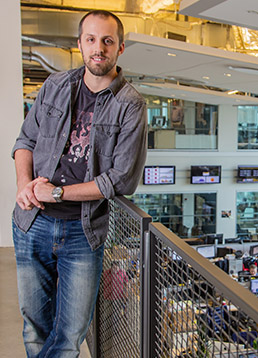
Brandon Klein (B.F.A. ’07) is a video editor for NBC Sports.
“Anyone can tell you a score,” says Brandon Klein (B.F.A. ’07). “I like to brainstorm ideas, take the footage, and cut teasers and long-form shows to figure out the best story.”
In his role as a video editor at NBC Sports, Klein works with his colleagues to humanize professional athletes and show the work and sacrifices needed to be the best. Klein is a big soccer fan, and one of his favorite storylines he helped craft was last year’s astonishing championship win by the Leicester City Football Club in the English Premier League. “Casino sites gave them 5,000 to 1 odds to win the league,” he says. “We got to tell the story of a team that came out of nowhere. It was lots of fun.” (Watch at bit.ly/Brandon-Klein.)
Broadcast sports continue to generate big ratings and big revenues. In 2015, Advertising Age reported that sports accounted for 37 percent of TV ad spending, totaling $8.47 billion in sales for ABC, CBS, NBC, and Fox. That same year, NBC agreed to a six-year deal for $1 billion to broadcast Premier League games. And Klein’s editing isn’t limited to English football clubs. During the Summer Olympics in London in 2012, he worked on the official games website and produced analysis videos that featured announcer commentaries. He also coordinates live replays during the Tour de France.
Klein credits his NYIT education with giving him insight into the editing process. “I learned that there is a difference between knowing how to use editing software and knowing how to edit,” he says. “Editing is a craft that you refine. It’s more than just knowing the technical specs.”
Live From New York
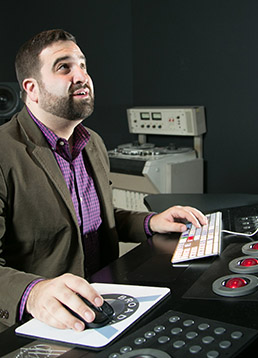
Nick Pacchiano (B.F.A. ’10) is technical director of multimedia at Broadway Video in New York City.
Nicholas Pacchiano (B.F.A. ’10) chose to attend NYIT for, as he puts it, “nerdy reasons.” Growing up in Brightwaters, N.Y., he read about NYIT’s legacy during the early days of computer animation, including the Computer Graphics Lab, home to industry pioneers like Ed Catmull and Alvy Ray Smith, the co-founders of Pixar. “The quality of NYIT’s work attracted the attention of George Lucas, who was interested in developing a CGI special effects facility at Lucasfilm. I wanted to be part of where those guys came from,” says Pacchiano.
Today, he works with top names in the world of entertainment and broadcasting as technical director of multimedia at Broadway Video in New York City.
Pacchiano describes the production company, which was founded by Lorne Michaels in 1979, as a “hotel for creativity.” Broadway Video develops programming for TV shows including Saturday Night Live (where Pacchiano helps produce its famed digital shorts), The Tonight Show Starring Jimmy Fallon, Late Night with Seth Meyers, Portlandia, and Documentary Now!
For Comedians in Cars Getting Coffee, a series created and hosted by Jerry Seinfeld, Pacchiano worked for seven years as a technical editor alongside the comedy legend.
“Jerry comes in to view all of the footage, and we relive the six-hour day he spends with each guest star,” he says. “After he decides what jokes are funny, we cut it down to four hours. Then we watch it again and cut it down to 60–90 minutes.” The team eventually cuts the episode down to 30 minutes or less. “That dissection process with Jerry Seinfeld is amazing,” Pacchiano adds. “He’s created an educational language for understanding comedy.”
Pacchiano also oversees the color and audio restoration on older sketch comedy shows like The Kids in the Hall and Monty Python’s Flying Circus. “Part of the comedy from these shows are the low production values, so you have to find that fine line in restoring old comedy shows without compromising the comedy itself,” Pacchiano says.
His latest venture is archiving metadata for TV shows going to over-the-top content (OTT) marketplaces. (OTT content refers to media delivered via the Internet that does not require traditional cable subscriptions or pay TV services.) This ensures that each piece of content on the streaming service has accurate titles, cast and crew credits, even wardrobe details attached to it. The information is essential for producing second screen experiences where a mobile device displays interactive content while a show airs.
“Second screen experiences are becoming more important for marketers,” says Pacchiano. “If I’m watching a show like Man Seeking Woman, I can view second screen content on my smartphone. So if I like the jacket that a character is wearing, I’ll already have that info at my fingertips.”
It’s another step in how technology continues to disrupt how broadcasters generate content and how viewers consume it.
“It’s so crazy to see where the industry is going right now,” says Pacchiano. “There is such an open playing field. As long as you’re surrounded by good people and good ideas, there is nothing to hold you back.”
This article originally appeared in the Winter 2017 issue of NYIT Magazine. Read more articles.
